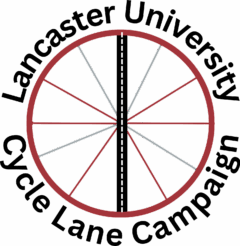On 23rd January 2025, members of the A6 Cycle Lane Campaign — including Lancaster University students, a lecturer, a Dynamo member, and local councillor Gina Dowding — met with representatives from Lancashire County Council’s Active Travel team following months of public pressure and a petition that gathered 1,412 signatures in support of safe, segregated cycle lanes between Lancaster University and the city centre.
The meeting came only after the group challenged an inadequate, unsigned email response from the Council, which failed to address the community’s concerns. With Gina Dowding’s help, a meeting was secured to push for meaningful dialogue. Unfortunately, the meeting ended with no firm commitments from the County Council.
Key Takeaways from the Meeting
-
Priority Route Decision Pending: The Council confirmed that priority routes for the Local Cycling and Walking Infrastructure Plan (LCWIP) are currently being assessed and will be decided within two months. They agreed to update the group in one month.
-
£750,000 Pointer Roundabout Funding: There is £750,000 earmarked for improvements to the Pointer Roundabout. Richard Askew (Active Travel team) said he would follow up with the Road Safety Team regarding the status of this funding. We are still awaiting an update.
-
Funding Sources Still Unclear: The Council acknowledged the need to identify funding but offered no clear answers. We requested a list of potential funding sources (e.g. Integrated Transport Block Funding), which Richard Askew committed to sending. We’re still waiting.
-
Feasibility Study Contradiction: A key concern was the contradiction in the Council’s reasoning: while they claim a feasibility study is now needed before any A6 cycle lane can proceed, they previously said one had already been conducted under the now-defunct Housing Infrastructure Fund (HIF) scheme. This raises serious questions about the Council’s internal communication and transparency.
-
What Happened to the Bailrigg Scheme? The Council had previously developed a cycling scheme for the A6 linked to Bailrigg Garden Village as part of the HIF work. We asked what became of these plans and why they aren’t being used now. No clear explanation was provided.
-
Economic Growth Argument: If the Council truly believes that cycling infrastructure supports “economic growth” (as they stated), then why not invest in the A6 cycle lanes using the £20 million economic development fund they referenced?
-
University Partnership? When asked about potential funding or collaboration with Lancaster University, the Council failed to provide a clear answer or identify a point of contact. We believe this is a missed opportunity.
Our Concerns
While the meeting provided space for discussion, the Council’s response amounted to a polite “no”—masked by vague promises, procedural delays, and contradictory statements. We’re deeply concerned by the lack of concrete actions, timelines, or accountability, especially given the overwhelming public support for this vital infrastructure.
Lancashire deserves a transport system that prioritises safety, sustainability, and accessibility. We will continue to push for answers, clarity, and a real commitment to delivering segregated cycle lanes on the A6.
